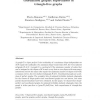TCS
2010
13 years 2 months ago
2010
The Correlation Clustering problem, also known as the Cluster Editing problem, seeks to edit a given graph by adding and deleting edges to obtain a collection of disconnected cliq...
JCT
2007
13 years 4 months ago
2007
We prove a number of relations between the number of cliques of a graph G and the largest eigenvalue (G) of its adjacency matrix. In particular, writing ks (G) for the number of s...
ENDM
2008
13 years 4 months ago
2008
A graph G is clique-perfect if the cardinality of a maximum clique-independent set of H equals the cardinality of a minimum clique-transversal of H, for every induced subgraph H o...
CATS
2008
13 years 6 months ago
2008
The problem of deciding whether the edge-set of a given graph can be partitioned into at most k cliques is well known to be NP-complete. In this paper we investigate this problem ...
ILP
2003
Springer
13 years 9 months ago
2003
Springer
In this paper, we investigate condensation of a clause. First, we extend a substitution graph introduced by Scheffer et al. (1996) to a total matcher graph. Then, we give a correc...
IPPS
2008
IEEE
13 years 11 months ago
2008
IEEE
We present a junction tree decomposition based algorithm for parallel exact inference. This is a novel parallel exact inference method for evidence propagation in an arbitrary jun...
Book
A classic book on graph theory.
Book
Markov random field (MRF) theory provides a basis for modeling contextual constraints in visual processing and interpretation. It enables us to develop optimal vision algorithms sy...

